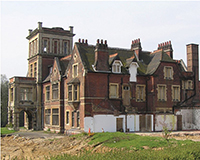The owner of a former hospital in Camden that was refused permission to demolish it and build what would be a valuable eight-bedroom house in its place has taken the matter to the High Court.
The case raises an issue as to the scope of the “replacement exception” to the presumption against new buildings, under paragraph 89 of the National Planning Policy Framework.
Athlone House Ltd (“AH”) sought permission to demolish and redevelop, rather than persist with earlier plans to carry out a repair and conversion of the existing property that it says would cost up to £25m.
It says that the inspector that rejected its appeal exceeded his powers in refusing permission for the total redevelopment of Athlone House, on Hampstead Lane, London N6, lying near Hampstead Heath, Parliament Hill and Highgate School.
The house was originally a large 19th century dwelling, requisitioned during World War II for use as a hospital providing geriatric care. It closed in 2002, and earlier proposals to redevelop it as a single dwelling were rejected in 2011.
The latest scheme is demolition of the existing property and erection of an eight-bedroom home with underground parking. The London Borough of Camden failed to determine the application, and, last June, an inspector dismissed AH’s appeal.
AH claims that the inspector erred in his application to policy relating to metropolitan open land, in particular to the replacement exception in the NPPF.
AH says that the replacement dwelling that would result should have been measured against the development permitted by a 2005 planning consent for alteration and redevelopment, which has been partially implemented through demolition of certain extensions that had been made to Athlone House.
However, the inspector found that the exception could not be interpreted so as to apply to the part-implemented consented scheme which is unlikely to be built. He measured it against the building as it currently stands.
AH say that the inspector’s approach was wrong in law and the replacement exception should not be so limited; it says that the exception is capable of including a situation where there is an existing building in the process of alteration and extension and a different scheme is put forward for total replacement.
In addition, it challenges the inspector’s finding that “through a realistic programme of conservative repair the building is capable of economic reuse as a dwelling”. It says there was no evidence of that kind, with the estimated cost of repair agreed with the local authority to be in the range £17m to £25m.
The inspector had referred to this cost reflecting an extravagant and opulent level of fitting out, but AH says that this was a fundamental misunderstanding of the evidence.
Lawyers representing maintain that the inspector was entitled to reach the decision he did, having found the materially larger building that would result to be inappropriate development which would cause extensive harm, including to the openness of the metropolitan open land.
Athlone House Ltd v Secretary of State for Communities and Local Government Planning Court (Dove J) 20 October 2015










